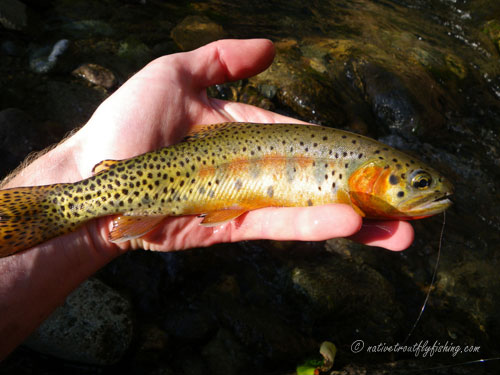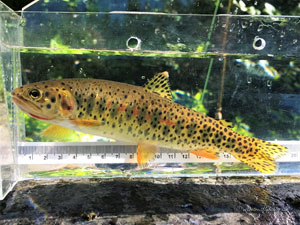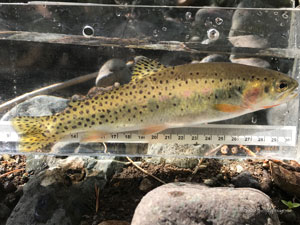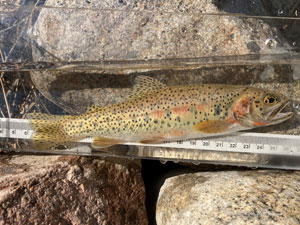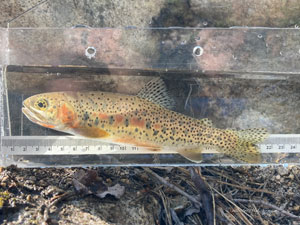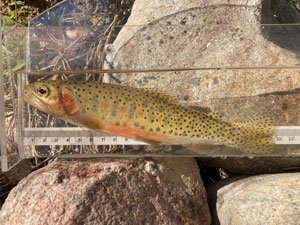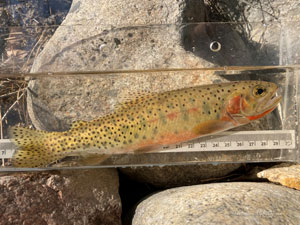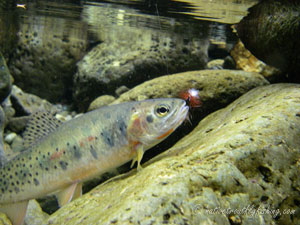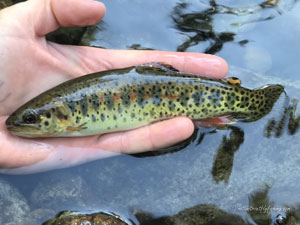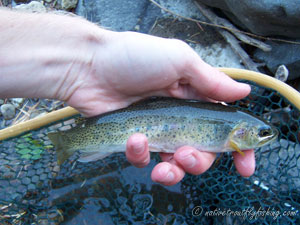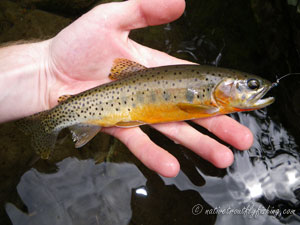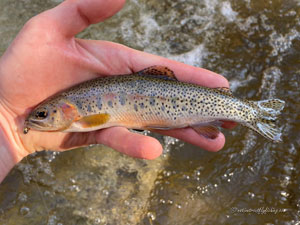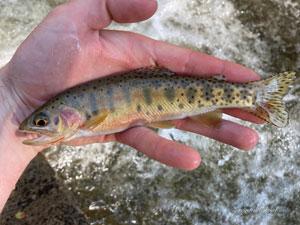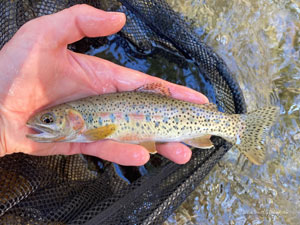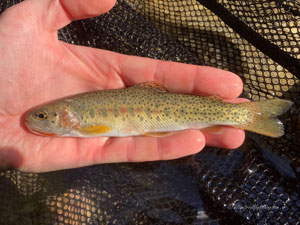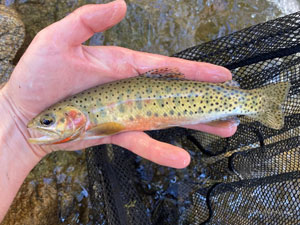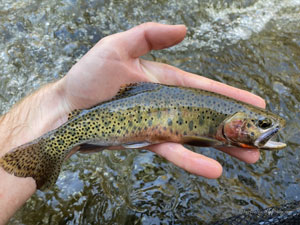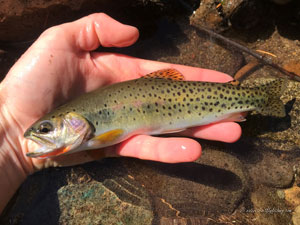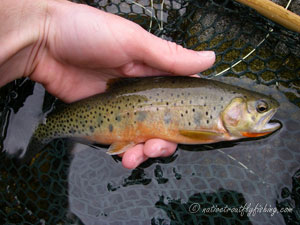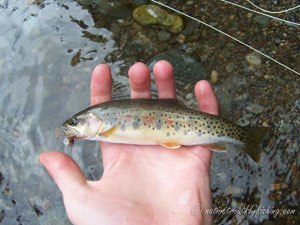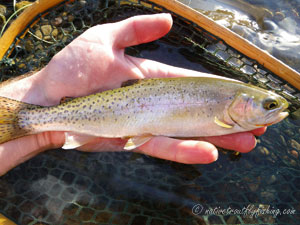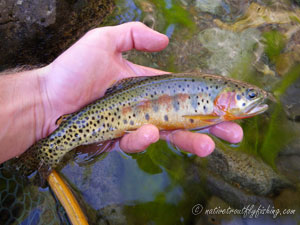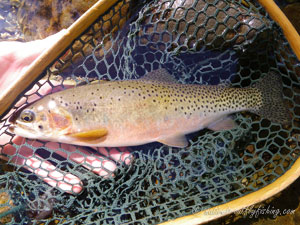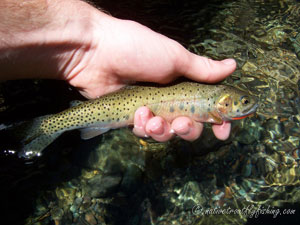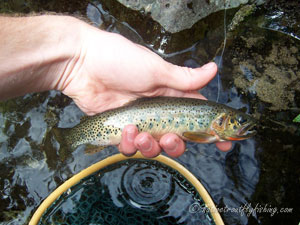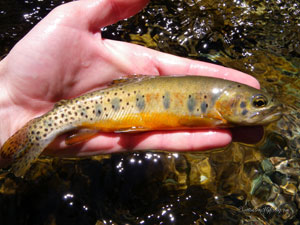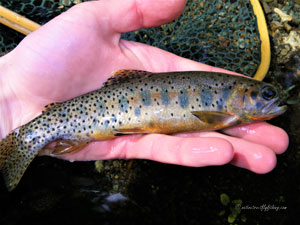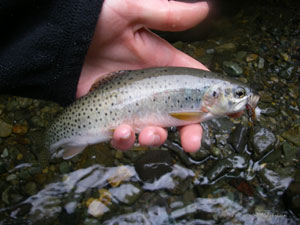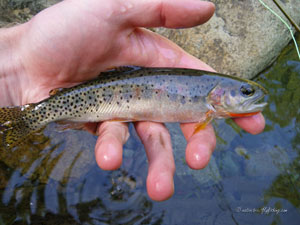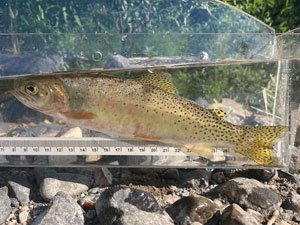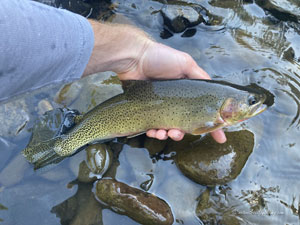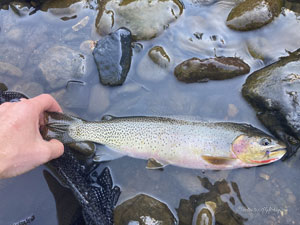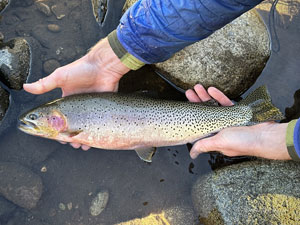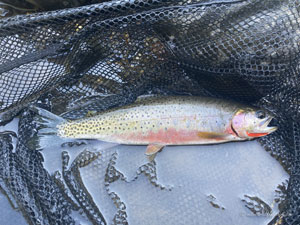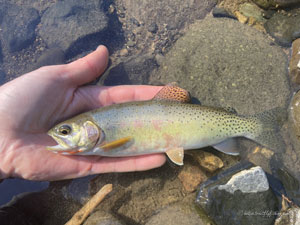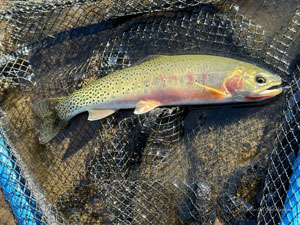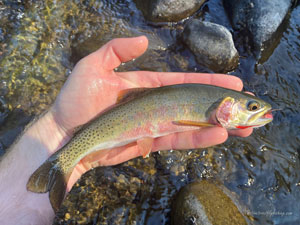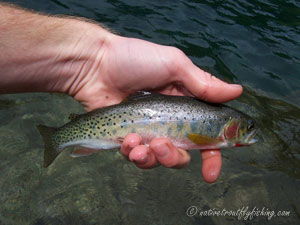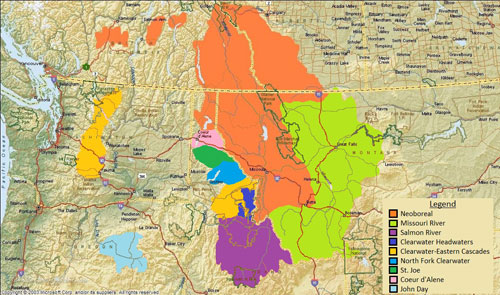Clearwater-Eastern Cascades Westslope Cutthroat
Oncorhynchus lewisi ssp.
A stream resident Clearwater-Eastern Cascades Westslope Cutthroat from Central Washington..
Introduction
The Clearwater-Eastern Cascades Westslope Cutthroat Trout are a subspecies of Westslope Cutthroat that are native to the mainstem Clearwater River, Locsha and Lower Selway Rivers in Idaho, as well as the Eastern Cascade Mountains from the Methow River to the Yakima River in Washington State (Trotter et al. 2001, Trotter et al. 2018, Young et al. 2018). However, it is possible that the populations in the Yakima River, may represent a unique lineage of Westslope Cutthroat as their genetics have not be compared to those of the other Westslope Cutthroat subspecies. Due to the Cutthroat populations in the Cascade Mountains being disjunct from the rest of the Westslope Cutthroat’s native range, there has been much debate as to whether native or not (Trotter 2008). Early reports document the occurrence of these fish in several river systems in the Cascade Mountains, and the Washington Department of Fish and Wildlife (WDFW) has used Westslope Cutthroat from initially Lake Chelan and later from Twin Lakes in the Wenatchee River drainage as a brood stock for planting alpine lakes around the state since 1903 and 1915 respectively (Crawford 1979, Behnke 1992, Behnke 2002). Historically, WDFW considered the populations of Westslope Cutthroat in Yakima basin to be introduced. However, the presence of populations where there are no records of introductions, genetic evidence as well as the unique spotting patterns found in these populations strongly suggest that they are native (Trotter et al. 1998). While there are over 150 miles (240 km) separating the populations of these Cutthroat in the Clearwater and Eastern-Cascade watersheds, it is possible that there were historically populations in other watersheds that bridged the gap between these drainages. Brown et al. (2004) showed that Columbia Basin Redband Trout in the upper Tucannon River have Westslope Cutthroat genes, despite there being no known native Cutthroat populations or records of introductions in the watershed. This suggests that Redbands likely invaded the watershed and replaced a native Westslope Cutthroat population at some point in the past. Beyond the known populations of Eastern-Cascades-Clearwater Westslope Cutthroat, it is also possible that there may be native populations resulting from headwater transfers in upper Skagit watershed, but genetic analyses have not yet been conducted to verify this.
Life History Information
The Clearwater-Eastern Cascades Westslope Cutthroat Trout exhibit stream resident, fluvial and adfluvial life history strategies. As these Cutthroat co-occur with Columbia Basin Redband Trout, they two species have co-evolved to utilize different parts of watersheds, with Cutthroat most often being found in the smaller streams in the upper watersheds. Like other Westslope Cutthroat, the Clearwater-Eastern Cascades subspecies is iteroparous and spring spawners.
Stream Resident Form
The stream resident life history form is dominant in most streams in the Eastern Cascades and occurs throughout the Clearwater drainage as well. Where they co-occur with Columbia Basin Redband Trout, stream resident Cutthroat populations typically predominate in the upper headwaters, while Redbands are dominant in the lower watersheds (Trotter et al. 1998). Stream resident fish are opportunistic drift feeders, preying on both aquatic and terrestrial invertebrates. These fish typically have a maximum lifespan of approximately 5 to 7 years and reach a maximum size of about 12” (30 cm). While stream resident Westslope Cutthroat are typically found in streams with summer water temperatures ranging from 45° F to 50° F (7° C to 13° C), in one Eastern Cascade stream, these Cutthroat were observed in water temperatures ranging from 40° F to 74° F (4.5° C to 23° C) (Trotter et al. 2001). Spawning occurs between March and July and the first spawning typically when the fish are between age-4 and age-5 (Behnke 1992). Spawning in stream resident populations in the Eastern Cascades has been observed in late-June (Trotter et al. 1998).
Fluvial (River Migrant) Form
While it is not as common in Eastern Cascade watersheds due to the presence of Columbia Basin Redband Trout, the fluvial life history form of these Cutthroat is common in the Clearwater watershed as well as the Stehekin watershed where are Redbands were not native. In the Clearwater watershed, fluvial Cutthroat typically rear in their natal tributaries for until age-2 to age-4. After migrating into the mainstem Loscha or Selway River, these fish will migrate up and downstream based on water temperatures and prey availability (IDFG 2013). These fish are a maximum size of around 19” (47.5 cm), preying opportunistically on aquatic and terrestrial invertebrates, salmon eggs and fish. Fluvial Cutthroat from the Locsha and lower Selway often migrate downstream up to 62 miles (100 km) into the Clearwater River from late fall through early winter to overwinter (IDFG 2013). These overwintering Cutthroat will typically hold in the lower watershed until their spawning migration in April and May or June for non-spawners when water temperatures rise, and they migrate back upstream. Spawning generally occurs in tributary streams once water temperatures rise above 43° F (6° C), with juveniles emerging during June and July.
Adfluvial (Stream to Lake Migrant) Form
Adfluvial populations of Westslope Cutthroat historically occurred in a number of lakes across the range of the Clearwater-Eastern Cascades Westslope Cutthroat. While it is unclear if the population of Westslope Cutthroat from Twin Lakes is native to the lakes, they represent one of the best studied adfluvial populations of this subspecies of Cutthroat. Most lacustrine populations migrate to inlet streams to spawn, but the population at Twin Lake in Washington is known to spawn in the lake's outlet stream. These fish typically spawn in June shortly after the lakes become ice free at between age-4 and age-6 with females laying an average of 517 eggs (Crawford 1979). Adfluvial Cutthroat in Lake Chelan historically spawned between April and June and are currently believed to spawn between July and August (WDFW 2002). However, Johnson and Archibald (2009), showed that at least some spawning still takes place between mid-May and late-June with fry emerging by the end of July. Adfluvial populations of Clearwater-Eastern Cascades Westslope Cutthroat generally reach a maximum size of around 18” (46 cm) and are opportunistic feeders, primarily preying on aquatic and terrestrial invertebrates, but also feeding on fish when available.
Status
The Clearwater-Eastern Cascades Westslope Cutthroat Trout as with other Westslope Cutthroat were petitioned to be listed as under the Endangered Species Act in 1997 due to declines across their native range, but it was determined that listed status was not warranted (USFWS 1996, USFWS 2003). While the Clearwater-Eastern Cascades Westslope Cutthroat still occur throughout much of their native range, they have been impacted by habitat destruction, overfishing and the introduction of non-native fish.
The primary form of habitat destruction to impact Clearwater-Eastern Cascades Westslope Cutthroat has been timber harvest. Much of the Eastern Cascades, as well as the Clearwater drainage have been intensively logged and have a high density of logging roads. This has likely limited the abundance of these Cutthroat due to sedimentation, a loss of riparian vegetation and increased water temperatures. Beyond habitat destruction, overfishing has also led to a significant decline in the abundance of the Clearwater-Eastern Cascades Westslope Cutthroat. In the Clearwater drainage, harvest impacts increased significantly after U.S. Highway 12 was completed in 1962. While a 1956 creel survey estimated the catch of these Cutthroat to be 5,948 fish, by 1976 the catch had dropped to 654 Cutthroat (IDFG 2013). As a response to this, catch and release regulations were adopted in 1977. The results of this change were almost immediate, with Cutthroat densities increasing seven-fold by 1981 and the size of the fish also increasing substantially (IDFG 2013). A more drastic decline, with a less positive outcome occurred in Lake Chelan. Early reports on Cutthroat fishing in Lake Chelan, describe an exceptional fishery for large abundant native trout (WDFW 2002). However, due to a combination of habitat impacts, excessive collection of spawning adults for hatchery production and overfishing, by the 1920’s the Cutthroat fisheries in the lake were depleted, leading to increased hatchery supplementation with other species.
As with Lake Chelan, non-native salmonids were stocked throughout much of the native range of these Cutthroat due to declines in the abundance and to improve recreational fisheries. While there are also often low levels of hybridization between native Redband and Cutthroat where the two species overlap, when hatchery Rainbow Trout are planted hybridization becomes much more widespread (Howell et al. 2003). Hatchery Rainbow Trout were stocked in the Clearwater River from 1986 to 2010 to provide additional angling opportunities, although only sterile fish used between 2000 and 2010, in the Loscha River hatchery Rainbow Trout were stocked for decades, although this was discontinued in 1990 (IDFG 2013). Due to this stocking, hybridization with Rainbow Trout has been detected in many areas throughout the basin, with a few locations showing over 50% introgression (Weigel et al. 2003). Many populations in the eastern Cascade Mountains have also been impacted by hybridization with hatchery Rainbow Trout, with impacts being particularly significant in the Lake Chelan basin. The Lake Chelan Basin was stocked with hatchery Rainbow Trout from the early 1900’s until 2005 when all Rainbow Trout plants ceased and were converted to Twin Lakes stock Cutthroat (Ostberg and Chase 2012). Additionally, Lake Trout, Chinook Salmon and Kokanee Salmon (landlocked Sockeye) were all introduced into the lake, altering the food web, competing with and preying on native Westslope Cutthroat. A 2009 survey of tributaries to Lake Chelan predominately found introduced Rainbow Trout and Cutthroat-Rainbow Trout hybrids (Johnson and Archibald 2009). There has also been significant hybridization in the lower Stehekin River and the only pure populations remaining are found above migration barriers (Ostberg and Rodriguez 2006). However, in recent years the frequency of Rainbow Trout alleles found in fish in the upper river is declining suggesting that ecological or evolutionary processes may be restricting the spread of Rainbow Trout (Ostberg and Chase 2012). Given the change in stocking practices and the transition to more conservation minded fishing regulations across the range of the Clearwater-Eastern Cascades Westslope Cutthroat, it can be hoped that the declines these trout have suffered can be stemmed and that they once again thrive in their native waters.
Description
The Clearwater-Eastern Cascades Westslope Cutthroat is similar in appearance to other Westslope Cutthroat subspecies, but the populations the Eastern Cascades have some unique spotting pattern not typical of other Westslope Cutthroat subspecies. The “classic” phenotype of Westslope Cutthroat, which is found in the Clearwater drainage has moderately size spots concentrated on the posterior region of the body, as well as on the dorsal and caudal fins. According to Behnke (2002) if you were to draw an arc from the front of the anal fin to the pectoral fin, most of the spots would occur above this point. However, Cutthroat in the Cascades have been observed to exhibit five distinct spotting phenotypes including a classic large spotted, classic fin spotted, a minimal larger and fine spotted with few spots and a leopard spotted with spots distributed across the body above and below the lateral line (Trotter 2008). Small stream resident or immature fish generally have nine to eleven bluish-purple colored parr marks along their lateral line, which are often retained into maturity. However, this parr marks fade away on larger mature fluvial fish. The lower fins of these fish are a yellow to orange or peachy color. The cutthroat mark on these fish is a bright orange to crimson color and they typically have a purplish to orangish-red color on their gill plates. The coloration on the back of these fish is typically an olive or bronze color, that transitions to a greenish-gold color along the sides. Some fish may have reddish marks along their lateral line and sexually mature fish have orange bellies.
Eastern Cascades - Stream Resident Form
Click on images to view a larger picture
Eastern Cascades - Fluvial Form
Eastern Cascades - Adfluvial Form
Native Range
Above: A map of the native range of the Westslope Cutthroat trout. Data Sources: Behnke (2002), Trotter (2008) and Young et al. (2018). Below: A map of the native range of the Clearwater-Eastern Cascades Westslope Cutthroat Trout.
References
Behnke, R. J. 1992. Native trout of western North America. American Fisheries Society Monograph 6. American Fisheries Society, Bethesda, Maryland.
Behnke, R. 2002. Trout and Salmon of North America. Chanticleer Press, New York.
Brown, K.H., S.J. Patton, K.E. Martin, K.M. Nichols, R. Armstrong and G.H. Thorgaard. 2004. Genetic analysis of interior Pacific Northwest Oncorhynchus mykiss reveals apparent ancient hybridization with westslope cutthroat trout. Transactions of the American Fisheries Society 133:1078–1088.
Crawford, B.A. 1979. The origin and history of the trout brood stocks of Washington. Washington State Game Department. Fishery Research Report. Olympia Washington.
Howell, P, P. Spruell and R. Leary. 2003. Information regarding the origin and genetic characteristics of westslope cutthroat trout in Oregon and Central Washington. United States Forest Service. La Grande, Oregon. 18p.
IDFG. 2013. Management plan for the conservation of Westslope Cutthroat Trout in Idaho. Idaho Department of Fish and Game. Fisheries Bureau, Boise, Idaho.
Johnson, E. and P. Archibald. 2009. Lake Chelan Cutthroat Trout spawning ground surveys. 2009 Draft report. Entiat Ranger District. United States Forest Service. Wenatchee, Washigton.
Ostberg, C.O. and D.M. Chase. 2012. Temporal genetic monitoring of hybridization between native westslope cutthroat trout and introduced rainbow trout in the Stehekin River, Washington. Northwest Science 86(3): 198-212.
Trotter, P., B. McMillan, N. Gayeski, P. Spruell and R. Berkley. 1998. Genetic and phenotypic catalog of native resident trout of the interior Columbia River Basin: populations of the upper Yakima basin. Bonneville Power Administration, Portland, OR.
Trotter, P., B. McMillan, N. Gayeski, P. Spruell and M. Cook. 2001. Genetic and phenotypic catalog of native resident trout of the interior Columbia River Basin: populations in the Wenatchee, Entiat, Lake Chelan, and Methow River drainages. Bonneville Power Administration, Portland, OR.
Trotter, P. 2008. Cutthroat: Native Trout of the West. Second Edition. University of California Press, Berkley, CA.
Trotter, P., P. Bisson, B. Roper, L. Schultz, C. Ferraris, G.R. Smith and R.F. Stearley. 2018. A special workshop on the taxonomy and evolutionary biology of cutthroat trout. Pages 1-31 in Trotter P, Bisson P, Schultz L, Roper B (editors). Cutthroat Trout: Evolutionary Biology and Taxonomy. Special Publication 36, American Fisheries Society, Bethesda, Maryland.
USFWS. 1996. Endangered and threatened wildlife and plants; notice of final decision on identification of candidates for listing as endangered or threatened. FR 61:65581-64485.
USFWS. 2003. Endangered and threatened wildlife and plants: reconsidered finding for an amended petition to list the Westslope Cutthroat Trout as threatened throughout its range. FR 68:46989-47009.
WDFW. 2002. Lake Chelan fishery management plan. Washington Department of Fish and Wildlife. Olympia, Washington.
Weigel, D.E., J.T. Peterson and P. Spruell. 2003. Introgressive hybridization between native cutthroat trout and introduced rainbow trout. Ecological Applications 13(1): 38-50.
Young, M.K., K.S. McKelvey, T. Jennings, K. Carter, R. Cronn, E.R. Keeley, J.L. Loxterman, K.L. Pilgrim and M.K. Schwartz. 2018. The phylogeography of westslope cutthroat trout. Pages 261-301 in Trotter P, Bisson P, Schultz L, Roper B (editors). Cutthroat Trout: Evolutionary Biology and Taxonomy. Special Publication 36, American Fisheries Society, Bethesda, Maryland.
Contact
Feel free to contact me if you have any questions or comments
Clearwater-Eastern Cascades Westslope Cutthroat Trout Links
My Clearwater-Eastern Cascades Westslope Cutthroat Trips
Washington Department of Fish and Wildlife - Westslope Cutthroat Trout
Idaho Department of Fish and Game - Westslope Cutthroat Trout
Nez Perce-Clearwater National Forest
Mount Baker-Snoqualmie National Forest
Okanogan-Wenatchee National Forest
Western Native Trout Initiative - Westslope Cutthroat Trout
Native Trout Links
Truchas Mexicanas' - Native Trout of Mexico
Balkan Trout Restoration Group
Trout and Seasons of the Mountain Village - About Japanese Trout
Western Native Trout Challenge
California Heritage Trout Challenge
Fly Fishing Blogs
Dave B's Blog: Fly Fishing for Native Trout
The Search for Native Salmonids
Conservation Links
Western Native Trout Initiative
Fly Fishing Links
Fishing Art Links
Americanfishes.com - Joseph R. Tomelleri
